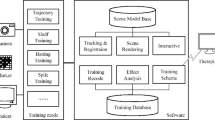Abstract
This paper presents a virtual reality (VR) system for upper limb rehabilitation. The system incorporates two motion track components, the Arm Suit and the Smart Glove which are composed of a range of the optical linear encoders (OLE) and the inertial measurement units (IMU), and two interactive practice applications designed for driving users to perform the required functional and non-functional motor recovery tasks. We describe the technique details about the two motion track components and the rational to design two practice applications. The experiment results show that, compared with the marker-based tracking system, the Arm Suit can accurately track the elbow and wrist positions. The repeatability of the Smart Glove on measuring the five fingers’ movement can be satisfied. Given the low cost, high accuracy and easy installation, the system thus promises to be a valuable complement to conventional therapeutic programs offered in rehabilitation clinics and at home.
Similar content being viewed by others
References
Taub E, Miller N E, Novack T A, Cook E W 3rd, Fleming W C, Nepomuceno C S, Connell J S, Crago J E. Technique to improve chronic motor deficit after stroke. Archives of Physical Medicine and Rehabilitation, 1993, 74(4): 347–354
Broeks J G, Lankhorst G J, Rumping K, Prevo A J. The long-term outcome of arm function after stroke: results of a follow-up study. Disability and Rehabilitation, 1999, 21(8): 357–364
Cirstea M C, Levin M F. Compensatory strategies for reaching in stroke. Brain, 2000, 123(5): 940–953
Rohrer B, Fasoli S, Krebs H I, Hughes R, Volpe B, Frontera W R, Stein J, Hogan N. Movement smoothness changes during stroke recovery. Journal of Neuroscience, 2002, 22(18): 8297–8304
Dickstein R, Heffes Y, Laufer Y, Abulaffio N, Shabtai E L. Repetitive practice of a single joint movement for enhancing elbow function in hemiparetic patients. Perceptual and Motor Skills, 1997, 85(3 Pt 1): 771–785
Glantz K, Rizzo A A, Graap K. Virtual reality for psychotherapy: Current reality and future possibilities. Psychotherapy (Chicago, Ill.), 2003, 40(1–2): 55–67
Popescu V G, Burdea G C, Bouzit M, Hentz V R. A virtual-reality-based telerehabilitation system with force feedback. IEEE Transactions on Information Technology in Biomedicine, 2000, 4(1): 45–51
Chen Y L. Application of tilt sensors in human-computer mouse interface for people with disabilities. IEEE Transactions on Neural Systems and Rehabilitation Engineering, 2001, 9(3): 289–294
Tao Y, Hu H, Zhou H. Integration of vision and inertial sensors for 3d arm motion tracking in home-based rehabilitation. International Journal of Robotics Research, 2007, 26(6): 607–624
Burdea G, Coiffet P. Virtual reality technology. New York: Wiley, 1994
Kong K, Tomizuka M. Control of exoskeletons inspired by fictitious gain in human model. IEEE/ASME Transactions on Mechatronics, 2009, 14(6): 689–698
Zhu R, Zhou Z. A real-time articulated human motion tracking using tri-axis inertial/magnetic sensors package. IEEE Transactions on Neural Systems and Rehabilitation Engineering, 2004, 12(2): 295–302
Lim K Y, Goh Y K, Dong W, Nguyen K D, Chen IM, Yeo S H, Duh H B L, Kim C G. A wearable, self-calibrating, wireless sensor network for body motion processing. In: Proceedings of IEEE International Conference on Robotics and Automation (ICRA), 2008, 1017–1022
Yu H L, Chase R A, Strauch B. Atlas of hand anatomy and clinical implications. Mosby, 2004
Dipietro L, Sabatini A M, Dario P. Evaluation of an instrumented glove for hand-movement acquisition. Journal of Rehabilitation Research and Development, 2003, 40(2): 181–189
Author information
Authors and Affiliations
Corresponding author
Rights and permissions
About this article
Cite this article
Luo, Z., Lim, C.K., Chen, IM. et al. A virtual reality system for arm and hand rehabilitation. Front. Mech. Eng. 6, 23–32 (2011). https://doi.org/10.1007/s11465-011-0202-6
Received:
Accepted:
Published:
Issue Date:
DOI: https://doi.org/10.1007/s11465-011-0202-6




